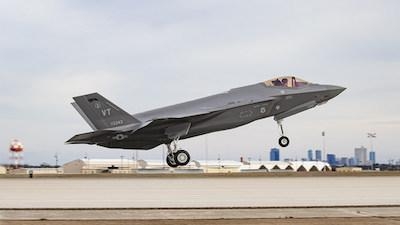Fri, Mar 15, 2024
After Years of Delays, the Lightning Graduates From Low-Rate Initial Production
The F-35 Lightning II, first taking to the skies in 2006, has finally been approved for full, genuine, actual showtime-ready mass production.

There are almost a thousand of the fighters out there in the wild already, but they've been built under provisionary Low-Rate Initial Production guidelines, limiting the scope of orders and allowing a little more variation until they could definitively identify the final mark to run with. It's a very delayed milestone, coming more than 20 years after the Joint Strike Fighter program really got to work on designing it, but it's finally come to pass. Years of teething issues and upgrade packages kept the F-35 on the waver wire, alternating between futuristic war-winner and caterwauling hangar queen. Right now, the Air Force is currently awaiting the rollout of Technology Refresh 3/TR-3 and the 4th block upgrade to the platform, which will hopefully iron out some of the irritations of the platform and modernize it with improved sensor suites, electronic warfare capabilities, and long-range strike accuracy.
Those who excitedly watched the development of the F-35 have had to watch a few faceplants along the way. The distinction of leaving LRIP isn't a tidal shift for the Lightning, since previous years have seen just as many aircraft produced as there would be under full production anyways. But it's a triumphant milestone for fans of the aircraft, though it's less a valedictorian and more a GED holder at this point. The Lightning has become undoubtedly capable by now - but it should be nothing but capable after 2 decades of development. Recent changes will improve it on many fronts, but they too will probably come with all new teething issues and problem-solving contracts. From now on, they can really let the production line fly, stamping out something north of 150 aircraft per year.
“This is a major achievement for the F-35 Program,” said Under Secretary for Acquisition and Sustainment William LaPlante. “This decision—backed by my colleagues in the Department—highlights to the Services, F-35 Cooperative Program Partners, and Foreign Military Sales customers that the F-35 is stable and agile, and that all statutory and regulatory requirements have been appropriately addressed. The F-35 Program is the premier system that drives interoperability with our allies and partners while contributing to the integrated deterrence component of our National Defense Strategy.”
More News
How To Get A Story On Aero-TV News/Feature Programming How do I submit a story idea or lead to Aero-TV? If you would like to submit a story idea or lead, please contact Jim Campbel>[...]
“As the excitement builds for the world of flight returning to Oshkosh in 2026, we wanted to ensure that advance tickets are available for those who enjoy giving AirVenture t>[...]
North Atlantic High Level Airspace (NAT HLA) That volume of airspace (as defined in ICAO Document 7030) between FL 285 and FL 420 within the Oceanic Control Areas of Bodo Oceanic, >[...]
Also: Cosmonaut Kicked Out, Airbus Scales Back, AF Silver Star, Russian A-60 Clobbered A Samaritan’s Purse humanitarian flight was hijacked on Tuesday, December 2, while atte>[...]
Also: IAE Acquires Diamond Trainers, Army Drones, FedEx Pilots Warning, DA62 MPP To Dresden Tech Uni The danger to the flight training industry and our future pilots is clear. Dona>[...]
 ANN FAQ: Contributing To Aero-TV
ANN FAQ: Contributing To Aero-TV Aero-News: Quote of the Day (12.10.25)
Aero-News: Quote of the Day (12.10.25) ANN's Daily Aero-Term (12.10.25): North Atlantic High Level Airspace (NAT HLA)
ANN's Daily Aero-Term (12.10.25): North Atlantic High Level Airspace (NAT HLA) Airborne 12.08.25: Samaritans Purse Hijack, FAA Med Relief, China Rocket Fail
Airborne 12.08.25: Samaritans Purse Hijack, FAA Med Relief, China Rocket Fail Airborne-Flight Training 12.04.25: Ldg Fee Danger, Av Mental Health, PC-7 MKX
Airborne-Flight Training 12.04.25: Ldg Fee Danger, Av Mental Health, PC-7 MKX



